SEO
How to Create an Affiliate Marketing Website That Converts
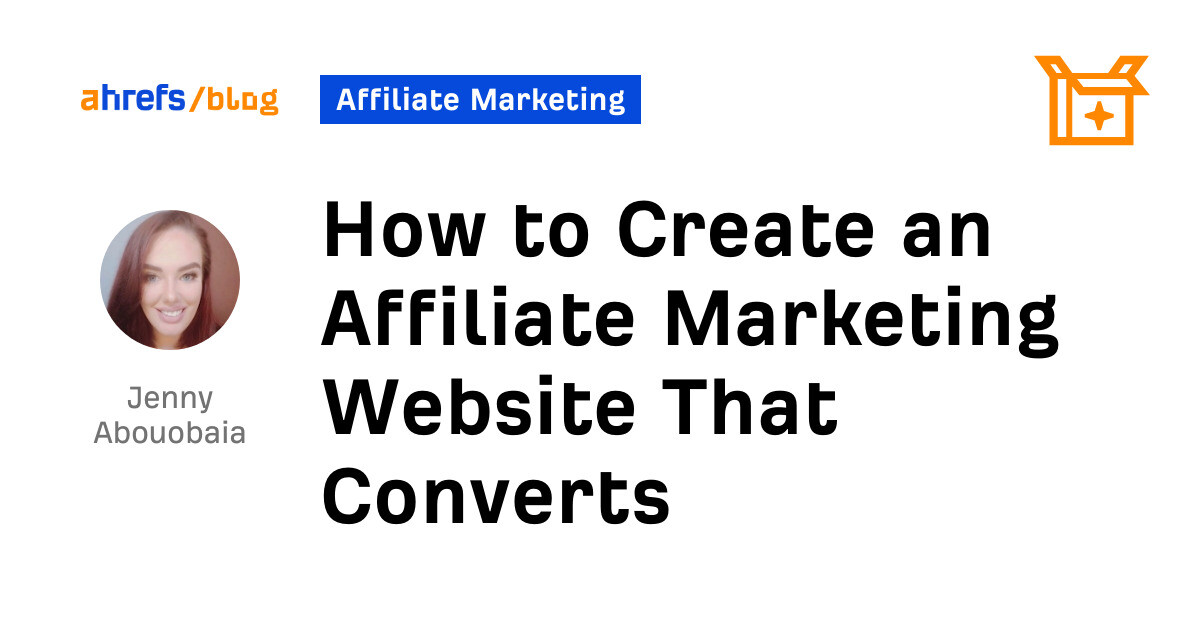
Would you love to replace your regular “9 to 5” and eventually generate passive income even when you sleep? A successful affiliate marketing website can do just that, and even beginners can earn additional income from the comfort of their own homes.
The concept of affiliate marketing involves advertising and promoting other people’s products or services and receiving a commission for each sale. The key is to build a website that can be an authoritative, trusted source and provide helpful content for your audience.
Anyone can build an affiliate marketing website earning at least four figures a month, but it’s not as easy as just throwing up any old site. To succeed, you must build a solid foundation to get off on the right foot.
As someone who has built, managed, bought, and sold affiliate sites over the years, I am going to tell you how to create an affiliate marketing website that actually converts and starts earning you income within a matter of months.
Like a referral service, affiliate marketing involves promoting products or services from another person or company. You can earn money by joining affiliate programs and plugging products on your website, blog, or social platforms suitable for your target audience.
Affiliate marketing is used by e-commerce sites, brands, and private companies in various industries to grow their customer base, traffic, and revenue. From designer handbags to psychic readings, there is an opportunity to promote almost anything.
According to eMarketer, 31% of U.S. brands said that affiliate marketing was the top revenue source in 2021. This should come as no surprise since affiliate marketing is a $12 billion industry.
Whether with a private affiliate program or through an affiliate network like Amazon Associates, once approved, you will be provided individualized links to website placements. You earn a commission when a user clicks a link and purchases an item.
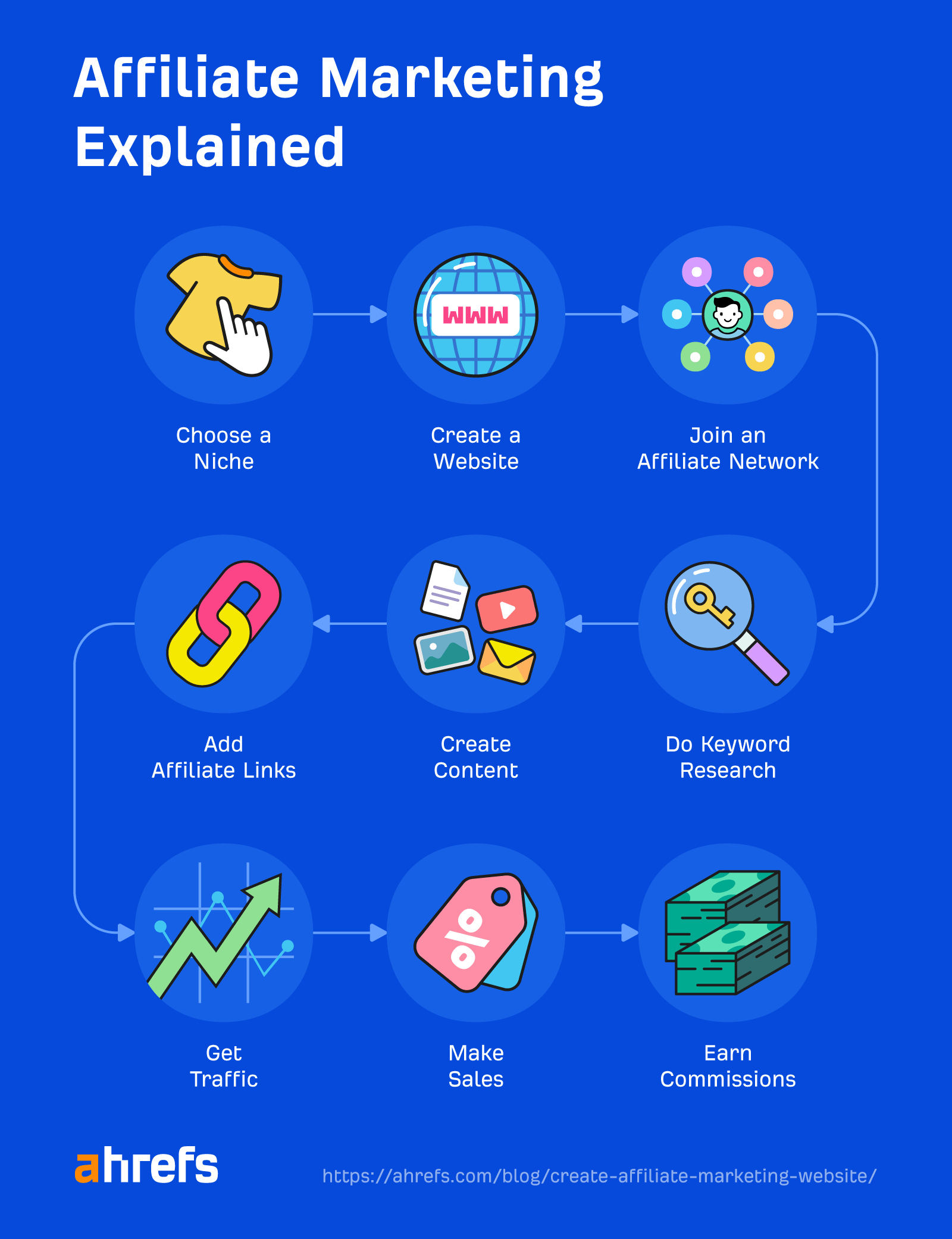
Who can be an affiliate?
The ability to become an affiliate marketer is open to everyone; however, you need specific skills, knowledge, and experience to succeed.
You’ll need to figure out the best niche for your site and what products to promote to get started. Then you’ll need an SEO-optimized, accessible website that offers high-quality content to your audience to be considered as an affiliate partner.
But it’s important to remember this is also a business. You’ll need a solid business plan and business management skills to successfully scale your site long-term.
Running an affiliate marketing website is an increasingly popular way to make money online. It is a desirable business strategy, as it can generate large returns with a small initial investment.
So why do so many people want to get into affiliate marketing? Let’s look at some of the top reasons.
Low acquisition cost
Affiliate marketing is a lucrative business concept for people looking to start a side business or earn an extra income due to its low initial cost.
If you have the skills and knowledge to create an affiliate marketing website yourself and write the initial content it needs to get off the ground, it will cost nothing more than your time and initial setup fees for hosting and a domain.
Even if you choose to buy an established site to speed up success, the likelihood is your ROI will quickly exceed the cost of acquiring the site.
No shipping or inventory required
Unlike e-commerce models, you don’t have to worry about inventory or shipping as an affiliate marketer. Because the sponsoring retailer or business handles these tasks. As a result, you can focus solely on promoting the goods and services of your affiliate partner.
You can earn income reasonably quickly
Although you may not earn six figures straight off the mark (which is definitely achievable over time), you can earn a decent income or at least enough to cover the costs of running your site within a matter of months.
In January 2023, I started an affiliate website on an aged domain that is now (just) generating four figures in affiliate commissions per month. Although the site is only just getting off the ground, commissions are steadily increasing (along with traffic).
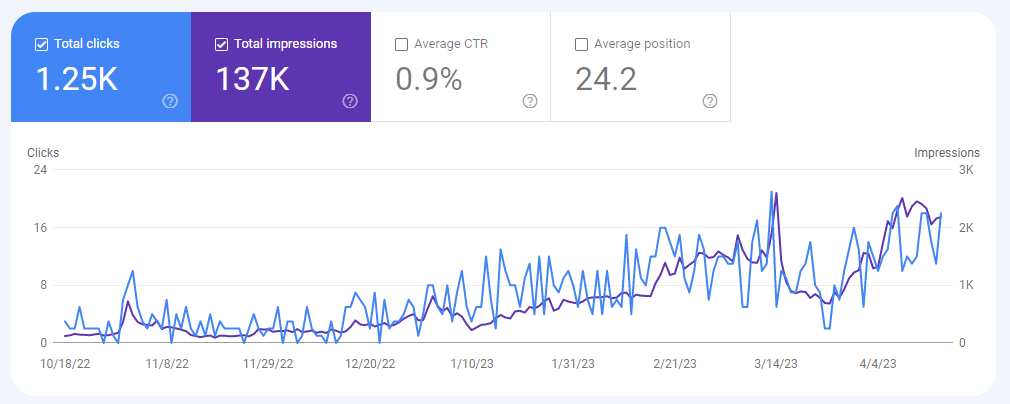
Granted, this site has a high-paying private affiliate at $80–$150 commission per sale (higher than most affiliate programs) in a specific but popular niche (low traffic with high conversion rates). But it shows it can be done.
Just for comparison, I also started another affiliate site around the same time in a different niche, which is solely monetized through Amazon Associates. This is also now earning affiliate commissions but at a significantly lower amount. Still, it’s earning.
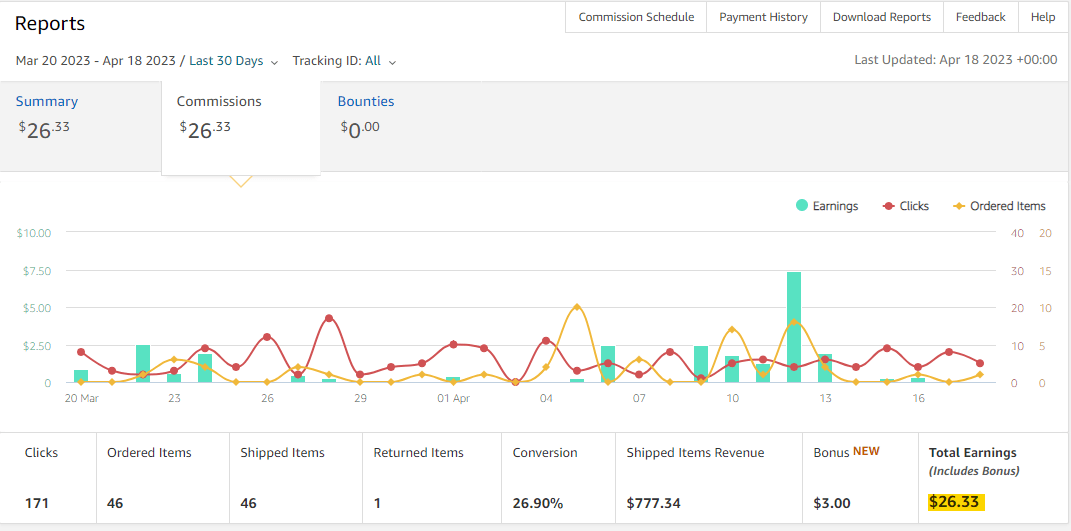
Flipping niche sites is also a highly profitable business model that many friends in the SEO community have their hand in. The idea is (much like flipping a house) to either build a site from scratch and sell it or buy an existing site, do some work on it, and sell it for a profit.
Affiliate sites sell now for anywhere between 30X to 40X their monthly income. That means if you can build a quality site that earns $1,000 a month within a few months, you can sell that site for anywhere between $32,000 and $40,000.
You can sell your site (or pick up a new one) from a reputable website marketplace like Flippa, Investors Club, or Empire Flippers.
These sites will assess your site and do full checks on the quality of your content and backlinks. This is to ensure you get an accurate estimate for your site and that a potential buyer doesn’t buy something that may be hit by a Google penalty.
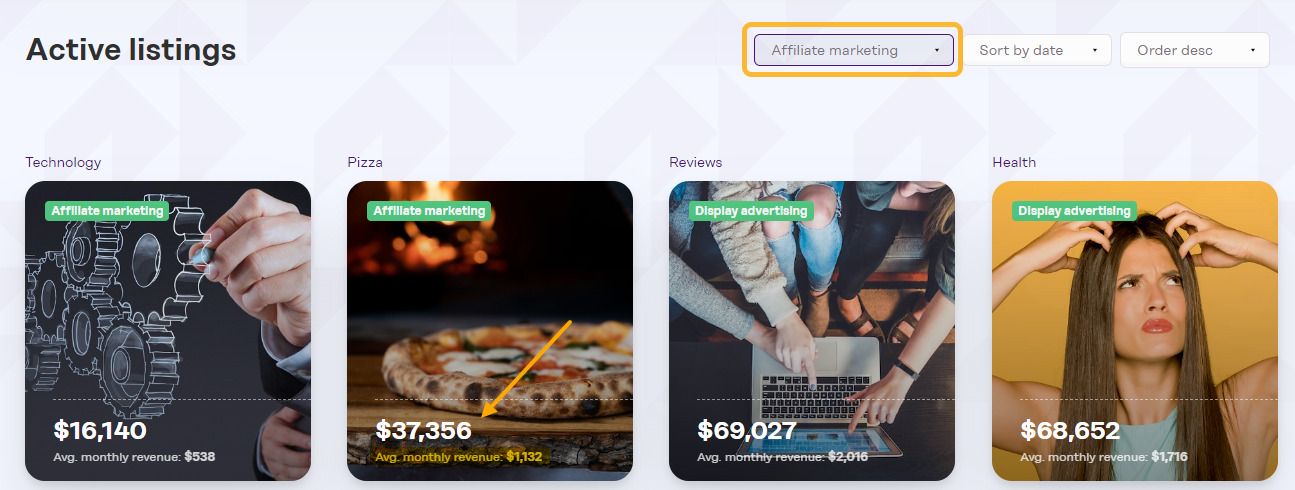
The bottom line is affiliate marketing allows you to make money without the hassle and expenses associated with traditional business models.
Now that we’ve covered what affiliate marketing is and who can become an affiliate marketer, I’m sure you’re chomping at the bit to find out how you can get started.
Let’s look at everything you need to do to create an affiliate website that has a solid foundation and is set up for success.
1. Identify your niche
To start an affiliate marketing website, you must identify your niche and target audience. The following steps will help you choose a niche.
Consider your expertise and interests
More experienced affiliate marketers will usually choose a niche solely on commission rates and products available. But when creating your first affiliate site, you may want to choose something closer to home.
Choosing a niche that you are knowledgeable about makes it easier to create relevant content yourself and stay interested.
Let’s say you love fishing and are well versed in everything related to the topic. You are relatively knowledgeable about the different types of fishing rods, fishing gear, required permits, and licenses. Fishing becomes a great niche that you can focus on.

The key is choosing a niche you are interested in but not your life’s greatest passion. If you’re too invested, handing the ropes over to writers and editors down the line will be difficult. This is something you will need to do to scale your affiliate site.
Do research to find popular niches
Now you’ve considered which niches you’re interested in, you need to consider other factors like if they are seasonal, are highly competitive, and offer the opportunity to scale in the long term.
A niche that is too broad may drive lots of traffic but will often have much lower conversions. Likewise, for a niche that is too specific, it will be hard to scale up over a number of years, as there simply may not be enough topics to cover.
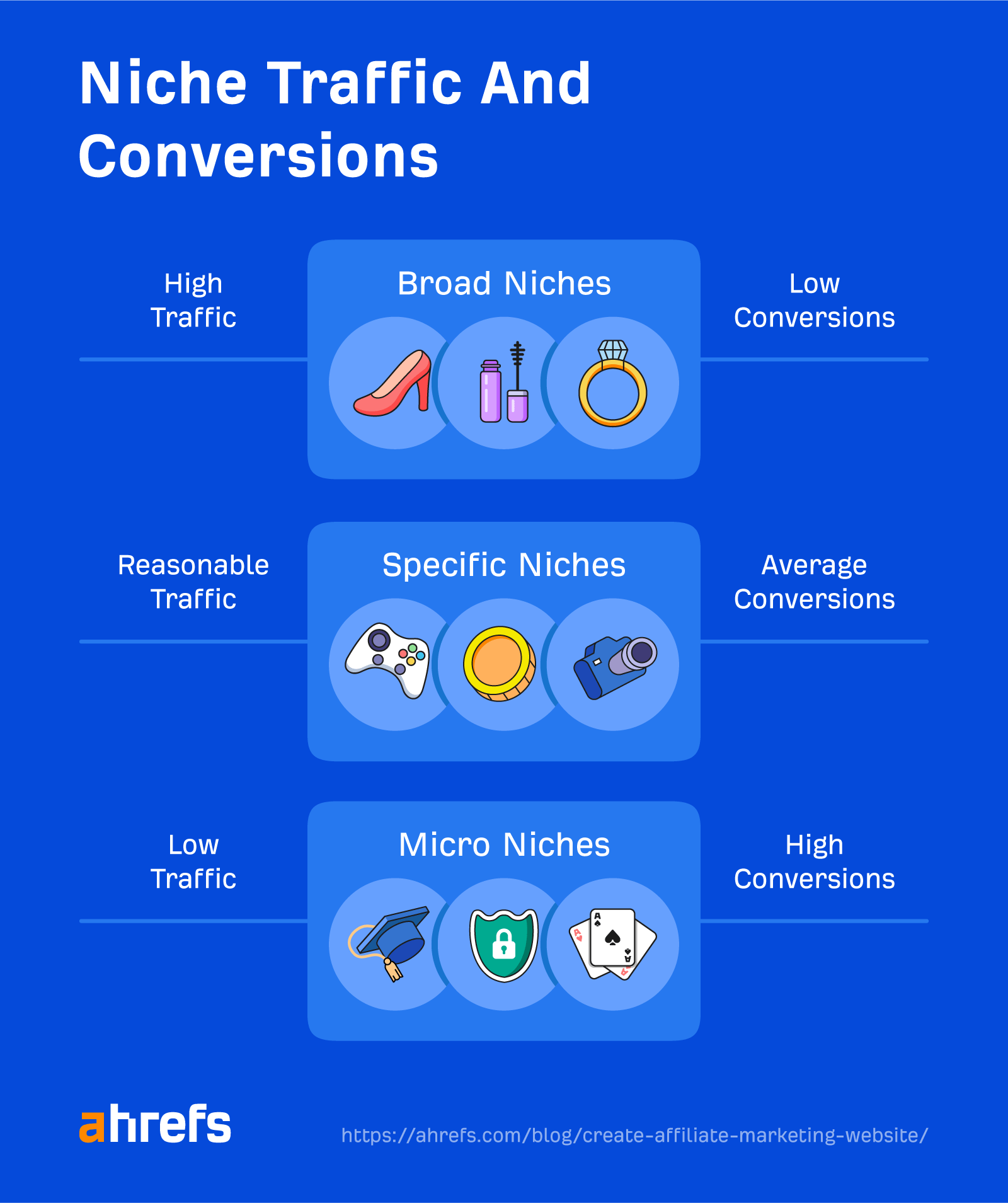
Perform a competitor analysis
Once you have identified a possible niche, you need to understand what sites are already out there and whether you can compete with them. That is where competitor analysis comes in.
By conducting competitor analysis, you can:
- Learn what works and what doesn’t in the chosen niche.
- Find niche competitors’ weaknesses and capitalize on them.
- Find competitors’ strengths and replicate them.
- Understand what SEO tasks to prioritize going forward.
- Understand how difficult outperforming competitors on the SERPs (search engine results pages) is likely to be.
This can give you a solid plan (as well as some inspiration) to get you started.
Consider niche profitability
Choosing a niche with a high profit potential is essential. Remember, it costs you the same to produce content for your site, regardless of the prices of the products you are promoting.
If you’re paying writers and editors to produce your content, you’re going to want to promote products where the commissions can at least cover the cost of production for that article. If your chosen niche only offers products under $10, it’s time to return to the drawing board.
The ideal scenario is to have a niche with multiple affiliate programs on offer, some of which should offer either a high commission percentage with high-ticket items (e.g., 10% commissions with items over $200) or a high set fee per commission (e.g., $100 per sale).
If you are a newbie, you may have to use a beginner affiliate program with lower commissions to start. But knowing you have the option to move to a bigger and better program as your site grows is important.
2. Choose the right affiliate programs
Once you’re set on a niche and know it has high profit potential, it is time to narrow down the affiliate programs you can partner with. You can look into both private affiliate programs and affiliate networks that are open to beginners.
You can find affiliate marketing programs suited to your specialty and market by searching online. Consider factors such as commission rates, payment schedules, and the program’s reputation.
Scouting affiliate networks is one of my favorite ways to find great affiliate programs. Affiliate networks like Commission Junction and ShareASale are a great place to start. Affiliate programs can be found in different categories in these networks.

When you search for a category, it will bring up several merchants with their key information, like commission per sale. Often, you can simply click a button and fill in a quick form to apply.

Using Google is one of the easiest ways to find independent affiliate programs.
Most online businesses offer some form of an affiliate program. Use site:domain.com + affiliate or (product name) + affiliate program to find programs.
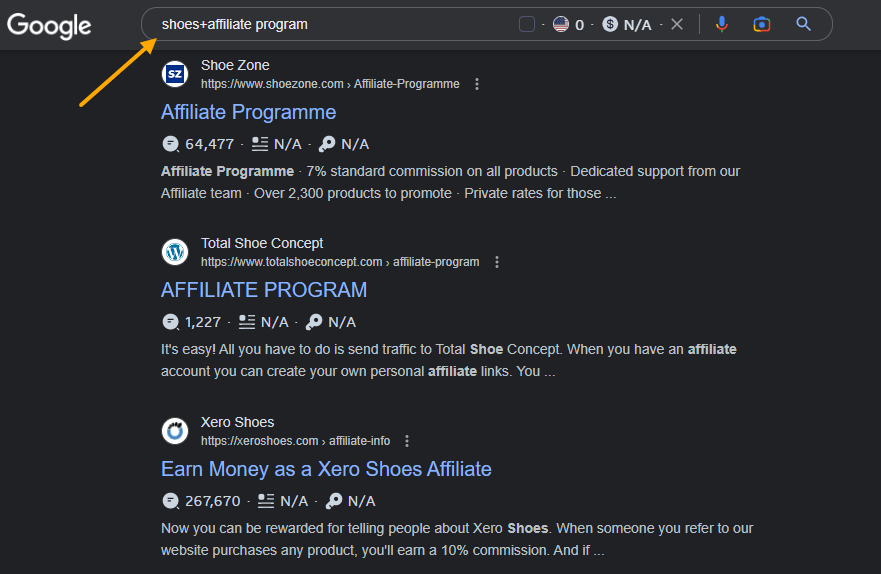
Simply click the link to head to the affiliate page for full information and how to apply.

Affiliate programs can also be found by reading product reviews on a competitor’s site. To find such sites, you can search for what a user is looking for.
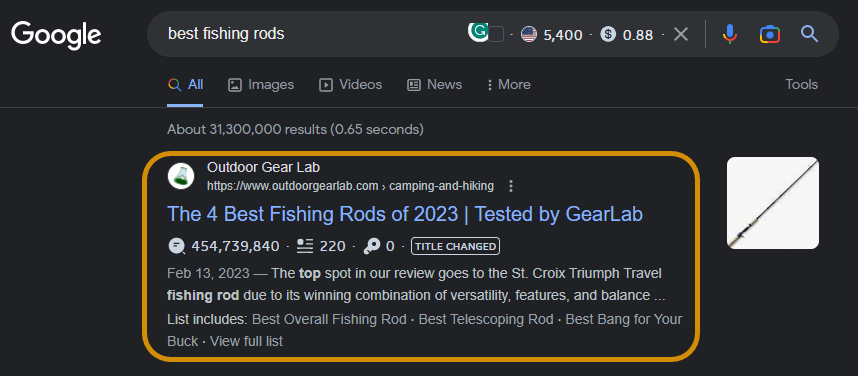

If you are just starting an affiliate marketing website, being able to promote products through a private affiliate may not be an option. Many programs want to know if you will drive traffic their way before approving you as a partner.
Because of this, you may need to (at least initially) join a beginner affiliate program so that once you’ve built up traffic, sales, and commissions, you can show those metrics to a private affiliate as part of your application.
Many affiliate programs suitable for newbies often have lower commission rates but are much more likely to accept you as a partner. Some top choices include:
- Amazon Associates Program – The Amazon Affiliate Program is one of the earliest affiliate programs and is considered one of the best for beginners. Earn 1% to 20% referral fees when affiliates share links that lead to sales.
- Rakuten – The Rakuten network includes affiliate programs for popular retailers such as Macy’s, Lego, and Wayfair. Products that are eligible for compensation through the Rakuten Affiliate Program are determined by each company and its Affiliate Program regulations.
- Impact – The Impact affiliate marketing platform connects customers with major brands such as Adidas, Uber, HSBC, and Airbnb. The company’s automation tools are known for streamlining campaigns and increasing sales.
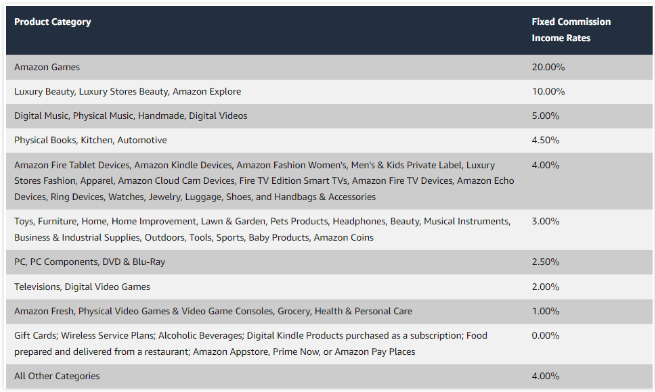
3. Build your affiliate marketing website
An affiliate marketing website requires a content management system (CMS), hosting provider, domain name selection, and plugin installation. If you would like to create a website for affiliate marketing, you should follow these steps:
Domain name selection
What’s in a name? I’m sure Mr. Shakespeare wasn’t talking about affiliate marketing websites, but it is quite an important decision.
Determining the best route for domain name selection will depend on a couple of factors:
- Do you want to build a site from scratch or start with a leg up?
- If you are building a site, are you hoping to flip it later or build a brand over several years?
First, you must choose whether to use a fresh domain, a dropped domain, or an aged domain.
You’re also going to have to consider whether you want an exact match domain (one that has the keywords in the name like fishingrodreviews.com), a partial match domain (something like fishingfriends.com), or a branded domain (something relevant like anglingdreamer.com).
Personally, I recommend using a branded domain because not only is there no evidence of keyword-based domains offering any kind of SEO bonus, but it will also help you with brand building as your business grows.
With a fresh domain (one you pick up from GoDaddy that has never been used before), you have the freedom to create whatever you want. If you’re planning to create a site that you will make your long-term business, this could be the best option.
A fresh domain may mean you start from scratch. But if you have dreams of being the next big name in your niche (like Healthline or Gear Lab), creating the perfect brand from the get-go will be important.
It might not be such a big deal, however, if you are just building a site to flip later.
With aged and dropped domains, you pick up a domain that was previously used and had a site on it. The benefits to this are that they often already have backlinks and some authority behind them, which could help you skip the elusive “Google sandbox.”
However, both of these types of domains come with their risks. If you are thinking of building a site on an aged or dropped domain, you’ll need to do full due diligence. Also, it is recommended to use a reputable marketplace like ODYS.

Choosing a host
There are plenty of reputable hosting companies to choose from. The ideal option is to choose a host that is super fast and offers everything that you need, such as automated backups and a CDN. However, some of these hosts may not be the most budget-friendly for those just starting out.
You may want to start with a beginner option like SiteGround, which is a good option for sites that don’t have a lot of traffic, and then upgrade once your site gets off the ground.
Set up a content management system
Deciding which content management system to use when building any website is crucial. There are many options out there, like Wix, Squarespace, and Shopify. But when it comes to affiliate marketing websites, WordPress is the best option.
Approximately 43% of websites on the internet use WordPress, making it the most popular CMS. As one of the most versatile CMSes, it offers functionality, customization, and versatility, making it ideal for affiliate websites.
Themes and plugins need to be installed
When working with WordPress, you will also need to choose a theme to get started. Choosing a theme that offers a professional and visually impressive user experience is important to gain trust with new users.
There are plenty of free options, but I personally prefer the AffiliateFish theme since it basically provides you with an affiliate site in a box. It is a paid theme, but it has everything you need, e.g., custom product boxes, comparison tables, etc.
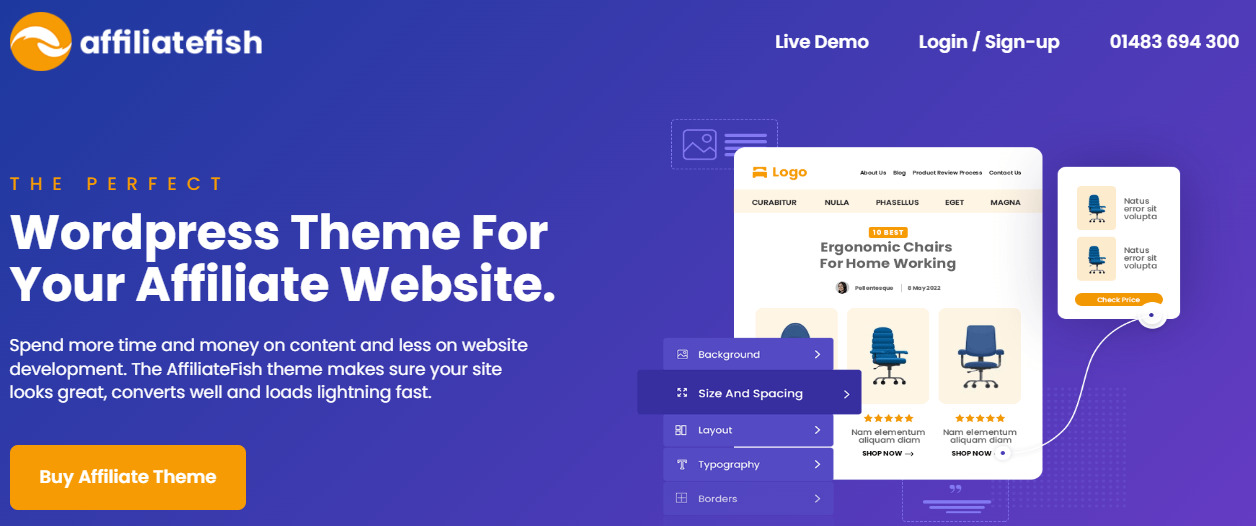
As far as plugins are concerned, you’ll want to limit how many you use, as they can slow down your site. Cache plugins, SEO plugins, and backup plugins are essential plugins. These plugins can improve your website’s functionality, safety, and search engine ranking.
However, there are some non-essential plugins that can help you when getting started with an affiliate site.
My top choices include the Ahrefs plugin to audit content and optimize for organic traffic, Link Whisper to automate internal links, and affiliate link cloaking plugins like Pretty Links or ThirstyAffiliates.
4. Design your website
For affiliate marketing, high-quality website design is vital for the following reasons:
- Branding – Designing your website can establish your brand identity and differentiate you from your competition.
- User engagement – Engagement and user experience can be affected by the design of your website. A clean and organized layout can make user navigation easier.
- Trust and credibility – A well-designed website is the first step in building trust and credibility with your audience. A visually appealing and professional website can enhance your audience’s perception of your recommendations and create a positive first impression.
- Conversion rates – Your affiliate marketing strategy’s conversion rates can be affected by the design of your website. Users who click on your affiliate links will be more likely to purchase if you have a clear call to action (CTA) and a user-friendly checkout process.
5. Create content that generates traffic and converts visitors into customers
Creating content is the bread and butter of any affiliate marketing site. It’s what gets your audience enthusiastic about the products you recommend enough that they click through to your partner site and earn you those all-important affiliate commissions.
Researching keywords is the first essential step in creating killer content. The three main types of keywords you need for any affiliate site are:
- General comparisons – Best dog bowl, best tarot cards, etc.
- Branded comparisons – Nike Air Max vs. Adidas Stan Smith.
- Product reviews – Samsung Tab A7 Lite review.
Of course, it’s important to do keyword research for any site. But with affiliate sites, by focusing on keywords with the right search intent, you can drive higher volumes of better-qualified traffic to your site that has a higher conversion rate.
What I mean by this is someone searching for a “Samsung Tab A7 Lite review” or “Samsung Tab A7 Lite vs. S6 Lite” clearly already has their eye on the product. They are simply looking for a deeper understanding of the product features and pros and cons before purchasing.
These types of content have much higher conversion rates because the reader has already decided they are looking to buy something.
You can find these types of keywords pretty easily using Ahrefs’ Keyword Explorer. Simply enter a list of brands or specific products, go to the Matching terms report, and select “Phrase match.” For branded comparisons, you can use the “Include” filter and enter “vs.”
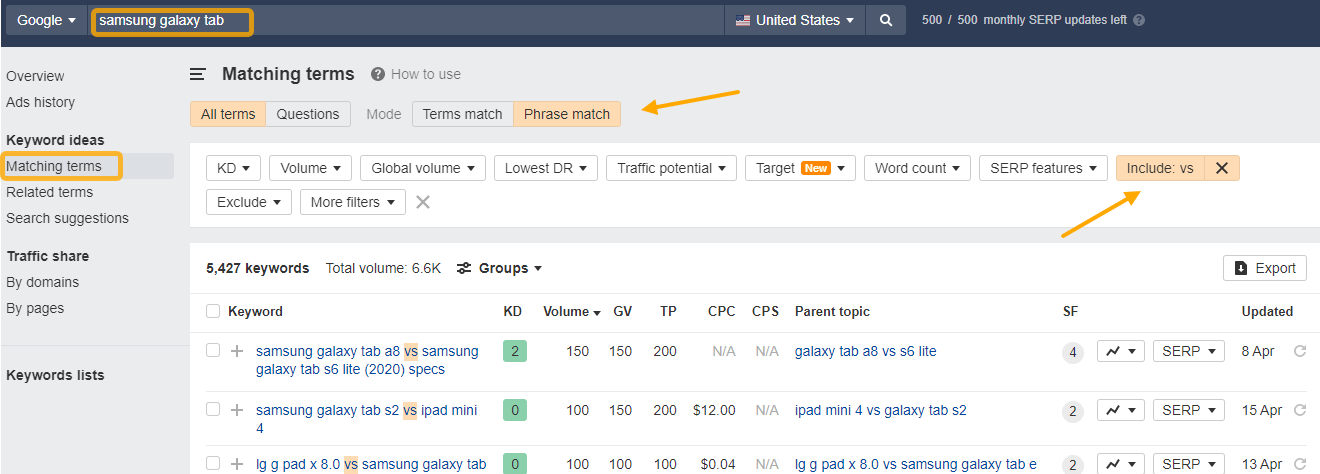
For product review keywords, simply change the “Include” filter to “review.”
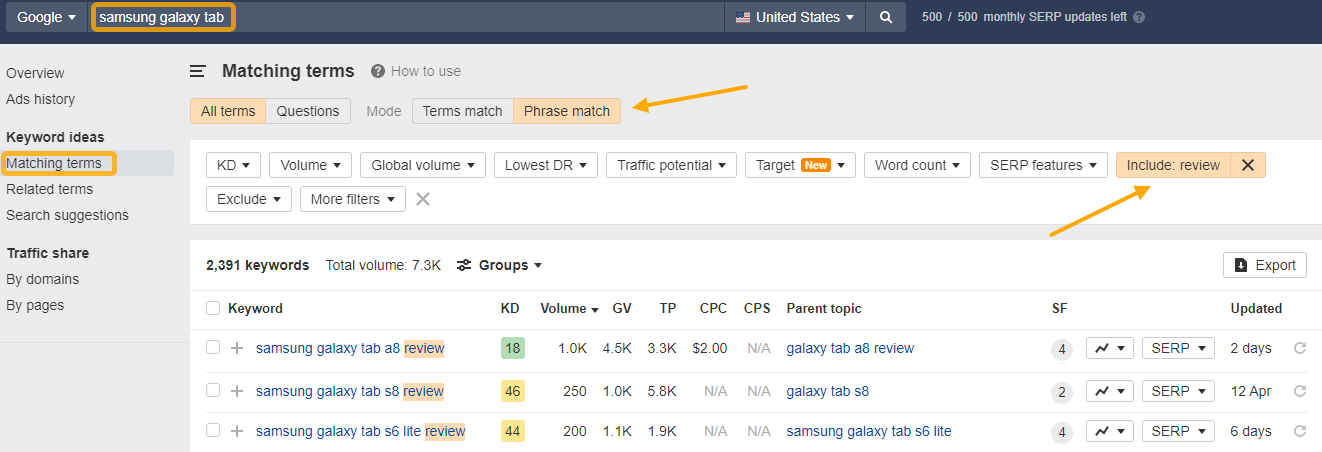
Then, with keywords at the ready, you can start producing highly engaging, evergreen content that your audience wants to read and share.
No matter what niche or what products you’re promoting, there’s one thing every piece of content should have in common: greatness!
Each article should be of top quality, i.e., well written, fun, and engaging. All of your content should be helpful and go the extra mile (where you can!). It should do more than regurgitate Amazon reviews.
This will encourage readers to buy recommended products and build a loyal audience who keeps returning to your site and sharing your content with others.
One of my favorite examples of a quality affiliate site is MyGolfSpy. This article on the “Best Blade Putters” is a great example of high-quality commercial content for a couple of reasons.
First, it starts the article by answering the question in the title and meeting search intent by listing its top putter choices broken down into categories.

Starting an article with a tl;dr (too long, didn’t read), quick product roundup, or “jump to review/recipe/etc.” section allows readers to get the answers they want quickly (meeting search intent) and encourages quick conversions.
Next, the article runs side-by-side comparisons of the top five putter choices for each category (best overall, best from 5 feet, best from 10 feet, etc.) and reviews the different putters’ features.

It also covers an in-depth guide on what you should be looking for in terms of weight, feel, length, and so on. There are also some FAQs and information on how individual putters were tested, showing that reviews are based on actual use and not just paraphrased Amazon reviews.
One of MyGolfSpy’s clever techniques is to use product placements as subtle CTAs. Instead of an overbearing and bold “buy now” or “get it here,” it lists an individual product with its key benefit, which encourages you to click on the one most relevant to you.

Including these techniques in your own content is a great way to ensure it is helpful, informative, and offers plenty of opportunities for conversions.
If you’re not sure where to start when putting together the different types of content you need for an affiliate site, this blog post template video from our affiliate marketing course with Sam Oh is a great place to start:
6. Drive traffic to your site
Once you have a beautifully designed site with high-quality content, it’s time to start driving visitors to your website. Although creating epic content is a great place to start, it’s not enough.
Using both paid and organic marketing to drive traffic will give you the best chances of success when creating an affiliate marketing website. These include:
- Search engine optimization (SEO) – Ensure your SEO is up to scratch! Alongside creating content, ensuring your technical and on-page SEO are on point and building backlinks will help you rank higher on the SERPs and drive organic traffic to your site.
- Social media – Developing a high-quality, entertaining social media plan that promotes your content across multiple channels can widen your audience and get more people to like and share your content.
- Grow your email list – Email is one marketing channel you can have full control over. Growing your email list by offering content upgrades (like a free ebook) allows you to reach out at any time to promote special events (like Black Friday) and diversify your offerings.
7. Rinse, repeat, and scale
Once you’re doing all the right things and driving traffic to your website, the only thing left is to keep going—but go bigger!
Double down on producing quality content, keep your technical and on-page SEO up to scratch, build more links, and keep promoting what you’re doing via social media. The more you do this, the more traffic you will drive to your site, and the more commissions you will earn.
Once you start scaling up your operation, you may want to start building a team to help you. That may be just someone to upload your content, an additional writer, or a social media assistant to start with. Every extra pair of hands helps you grow your business faster.
Final thoughts
Creating an affiliate marketing website is an incredibly lucrative business model. Regardless of whether you’re looking for a side hustle or a replacement for your full-time income, affiliate marketing is something everyone can get into.
Building an awesome website, producing top-notch content, and focusing on paid and organic traffic acquisitions are all key steps for building a successful affiliate site. To learn how to do it step by step, check out our free affiliate marketing course.
Just remember, success is subjective. Some may want to be the next household name in their niche, making seven figures a year. Others may just want to earn an extra $1,000 a month to pay off their student loans. The best part is that both are achievable.
Got questions? Ping me on Twitter.
SEO
Why Google Can’t Tell You About Every Ranking Drop

In a recent Twitter exchange, Google’s Search Liaison, Danny Sullivan, provided insight into how the search engine handles algorithmic spam actions and ranking drops.
The discussion was sparked by a website owner’s complaint about a significant traffic loss and the inability to request a manual review.
Sullivan clarified that a site could be affected by an algorithmic spam action or simply not ranking well due to other factors.
He emphasized that many sites experiencing ranking drops mistakenly attribute it to an algorithmic spam action when that may not be the case.
“I’ve looked at many sites where people have complained about losing rankings and decide they have a algorithmic spam action against them, but they don’t. “
Sullivan’s full statement will help you understand Google’s transparency challenges.
Additionally, he explains why the desire for manual review to override automated rankings may be misguided.
Two different things. A site could have an algorithmic spam action. A site could be not ranking well because other systems that *are not about spam* just don’t see it as helpful.
I’ve looked at many sites where people have complained about losing rankings and decide they have a…
— Google SearchLiaison (@searchliaison) May 13, 2024
Challenges In Transparency & Manual Intervention
Sullivan acknowledged the idea of providing more transparency in Search Console, potentially notifying site owners of algorithmic actions similar to manual actions.
However, he highlighted two key challenges:
- Revealing algorithmic spam indicators could allow bad actors to game the system.
- Algorithmic actions are not site-specific and cannot be manually lifted.
Sullivan expressed sympathy for the frustration of not knowing the cause of a traffic drop and the inability to communicate with someone about it.
However, he cautioned against the desire for a manual intervention to override the automated systems’ rankings.
Sullivan states:
“…you don’t really want to think “Oh, I just wish I had a manual action, that would be so much easier.” You really don’t want your individual site coming the attention of our spam analysts. First, it’s not like manual actions are somehow instantly processed. Second, it’s just something we know about a site going forward, especially if it says it has change but hasn’t really.”
Determining Content Helpfulness & Reliability
Moving beyond spam, Sullivan discussed various systems that assess the helpfulness, usefulness, and reliability of individual content and sites.
He acknowledged that these systems are imperfect and some high-quality sites may not be recognized as well as they should be.
“Some of them ranking really well. But they’ve moved down a bit in small positions enough that the traffic drop is notable. They assume they have fundamental issues but don’t, really — which is why we added a whole section about this to our debugging traffic drops page.”
Sullivan revealed ongoing discussions about providing more indicators in Search Console to help creators understand their content’s performance.
“Another thing I’ve been discussing, and I’m not alone in this, is could we do more in Search Console to show some of these indicators. This is all challenging similar to all the stuff I said about spam, about how not wanting to let the systems get gamed, and also how there’s then no button we would push that’s like “actually more useful than our automated systems think — rank it better!” But maybe there’s a way we can find to share more, in a way that helps everyone and coupled with better guidance, would help creators.”
Advocacy For Small Publishers & Positive Progress
In response to a suggestion from Brandon Saltalamacchia, founder of RetroDodo, about manually reviewing “good” sites and providing guidance, Sullivan shared his thoughts on potential solutions.
He mentioned exploring ideas such as self-declaration through structured data for small publishers and learning from that information to make positive changes.
“I have some thoughts I’ve been exploring and proposing on what we might do with small publishers and self-declaring with structured data and how we might learn from that and use that in various ways. Which is getting way ahead of myself and the usual no promises but yes, I think and hope for ways to move ahead more positively.”
Sullivan said he can’t make promises or implement changes overnight, but he expressed hope for finding ways to move forward positively.
Featured Image: Tero Vesalainen/Shutterstock
SEO
56 Google Search Statistics to Bookmark for 2024

If you’re curious about the state of Google search in 2024, look no further.
Each year we pick, vet, and categorize a list of up-to-date statistics to give you insights from trusted sources on Google search trends.
- Google has a web index of “about 400 billion documents”. (The Capitol Forum)
- Google’s search index is over 100 million gigabytes in size. (Google)
- There are an estimated 3.5 billion searches on Google each day. (Internet Live Stats)
- 61.5% of desktop searches and 34.4% of mobile searches result in no clicks. (SparkToro)
- 15% of all Google searches have never been searched before. (Google)
- 94.74% of keywords get 10 monthly searches or fewer. (Ahrefs)
- The most searched keyword in the US and globally is “YouTube,” and youtube.com gets the most traffic from Google. (Ahrefs)
- 96.55% of all pages get zero search traffic from Google. (Ahrefs)
- 50-65% of all number-one spots are dominated by featured snippets. (Authority Hacker)
- Reddit is the most popular domain for product review queries. (Detailed)
- Google is the most used search engine in the world, with a mobile market share of 95.32% and a desktop market share of 81.95%. (Statista)


- Google.com generated 84.2 billion visits a month in 2023. (Statista)
- Google generated $307.4 billion in revenue in 2023. (Alphabet Investor Relations)
- 63.41% of all US web traffic referrals come from Google. (SparkToro)
- 92.96% of global traffic comes from Google Search, Google Images, and Google Maps. (SparkToro)
- Only 49% of Gen Z women use Google as their search engine. The rest use TikTok. (Search Engine Land)
- 58.67% of all website traffic worldwide comes from mobile phones. (Statista)
- 57% of local search queries are submitted using a mobile device or tablet. (ReviewTrackers)


- 51% of smartphone users have discovered a new company or product when conducting a search on their smartphones. (Think With Google)
- 54% of smartphone users search for business hours, and 53% search for directions to local stores. (Think With Google)
- 18% of local searches on smartphones lead to a purchase within a day vs. 7% of non-local searches. (Think With Google)
- 56% of in-store shoppers used their smartphones to shop or research items while they were in-store. (Think With Google)
- 60% of smartphone users have contacted a business directly using the search results (e.g., “click to call” option). (Think With Google)
- 63.6% of consumers say they are likely to check reviews on Google before visiting a business location. (ReviewTrackers)
- 88% of consumers would use a business that replies to all of its reviews. (BrightLocal)
- Customers are 2.7 times more likely to consider a business reputable if they find a complete Business Profile on Google Search and Maps. (Google)
- Customers are 70% more likely to visit and 50% more likely to consider purchasing from businesses with a complete Business Profile. (Google)
- 76% of people who search on their smartphones for something nearby visit a business within a day. (Think With Google)
- 28% of searches for something nearby result in a purchase. (Think With Google)
- Mobile searches for “store open near me” (such as, “grocery store open near me” have grown by over 250% in the last two years. (Think With Google)
- People use Google Lens for 12 billion visual searches a month. (Google)
- 50% of online shoppers say images helped them decide what to buy. (Think With Google)
- There are an estimated 136 billion indexed images on Google Image Search. (Photutorial)
- 15.8% of Google SERPs show images. (Moz)
- People click on 3D images almost 50% more than static ones. (Google)
- More than 800 million people use Google Discover monthly to stay updated on their interests. (Google)
- 46% of Google Discover URLs are news sites, 44% e-commerce, 7% entertainment, and 2% travel. (Search Engine Journal)
- Even though news sites accounted for under 50% of Google Discover URLs, they received 99% of Discover clicks. (Search Engine Journal)


- Most Google Discover URLs only receive traffic for three to four days, with most of that traffic occurring one to two days after publishing. (Search Engine Journal)
- The clickthrough rate (CTR) for Google Discover is 11%. (Search Engine Journal)
- 91.45% of search volumes in Google Ads Keyword Planner are overestimates. (Ahrefs)
- For every $1 a business spends on Google Ads, they receive $8 in profit through Google Search and Ads. (Google)
- Google removed 5.5 billion ads, suspended 12.7 million advertiser accounts, restricted over 6.9 billion ads, and restricted ads from showing up on 2.1 billion publisher pages in 2023. (Google)
- The average shopping click-through rate (CTR) across all industries is 0.86% for Google Ads. (Wordstream)
- The average shopping cost per click (CPC) across all industries is $0.66 for Google Ads. (Wordstream)
- The average shopping conversion rate (CVR) across all industries is 1.91% for Google Ads. (Wordstream)
- 58% of consumers ages 25-34 use voice search daily. (UpCity)
- 16% of people use voice search for local “near me” searches. (UpCity)
- 67% of consumers say they’re very likely to use voice search when seeking information. (UpCity)
- Active users of the Google Assistant grew 4X over the past year, as of 2019. (Think With Google)
- Google Assistant hit 1 billion app installs. (Android Police)
- AI-generated answers from SGE were available for 91% of entertainment queries but only 17% of healthcare queries. (Statista)
- The AI-generated answers in Google’s Search Generative Experience (SGE) do not match any links from the top 10 Google organic search results 93.8% of the time. (Search Engine Journal)
- Google displays a Search Generative element for 86.8% of all search queries. (Authoritas)


- 62% of generative links came from sources outside the top 10 ranking organic domains. Only 20.1% of generative URLs directly match an organic URL ranking on page one. (Authoritas)
- 70% of SEOs said that they were worried about the impact of SGE on organic search (Aira)
Learn more
Check out more resources on how Google works:
SEO
How To Use ChatGPT For Keyword Research

Anyone not using ChatGPT for keyword research is missing a trick.
You can save time and understand an entire topic in seconds instead of hours.
In this article, I outline my most effective ChatGPT prompts for keyword research and teach you how I put them together so that you, too, can take, edit, and enhance them even further.
But before we jump into the prompts, I want to emphasize that you shouldn’t replace keyword research tools or disregard traditional keyword research methods.
ChatGPT can make mistakes. It can even create new keywords if you give it the right prompt. For example, I asked it to provide me with a unique keyword for the topic “SEO” that had never been searched before.
“Interstellar Internet SEO: Optimizing content for the theoretical concept of an interstellar internet, considering the challenges of space-time and interplanetary communication delays.”
Although I want to jump into my LinkedIn profile and update my title to “Interstellar Internet SEO Consultant,” unfortunately, no one has searched that (and they probably never will)!
You must not blindly rely on the data you get back from ChatGPT.
What you can rely on ChatGPT for is the topic ideation stage of keyword research and inspiration.
ChatGPT is a large language model trained with massive amounts of data to accurately predict what word will come next in a sentence. However, it does not know how to do keyword research yet.
Instead, think of ChatGPT as having an expert on any topic armed with the information if you ask it the right question.
In this guide, that is exactly what I aim to teach you how to do – the most essential prompts you need to know when performing topical keyword research.
Best ChatGPT Keyword Research Prompts
The following ChatGPT keyword research prompts can be used on any niche, even a topic to which you are brand new.
For this demonstration, let’s use the topic of “SEO” to demonstrate these prompts.
Generating Keyword Ideas Based On A Topic
What Are The {X} Most Popular Sub-topics Related To {Topic}?
The first prompt is to give you an idea of the niche.
As shown above, ChatGPT did a great job understanding and breaking down SEO into three pillars: on-page, off-page & technical.
The key to the following prompt is to take one of the topics ChatGPT has given and query the sub-topics.
What Are The {X} Most Popular Sub-topics Related To {Sub-topic}?
For this example, let’s query, “What are the most popular sub-topics related to keyword research?”
Having done keyword research for over 10 years, I would expect it to output information related to keyword research metrics, the types of keywords, and intent.
Let’s see.
 Screenshot from ChatGPT 4, April 2024
Screenshot from ChatGPT 4, April 2024Again, right on the money.
To get the keywords you want without having ChatGPT describe each answer, use the prompt “list without description.”
Here is an example of that.
List Without Description The Top {X} Most Popular Keywords For The Topic Of {X}
You can even branch these keywords out further into their long-tail.
Example prompt:
List Without Description The Top {X} Most Popular Long-tail Keywords For The Topic “{X}”
 Screenshot ChatGPT 4,April 2024
Screenshot ChatGPT 4,April 2024List Without Description The Top Semantically Related Keywords And Entities For The Topic {X}
You can even ask ChatGPT what any topic’s semantically related keywords and entities are!
 Screenshot ChatGPT 4, April 2024
Screenshot ChatGPT 4, April 2024Tip: The Onion Method Of Prompting ChatGPT
When you are happy with a series of prompts, add them all to one prompt. For example, so far in this article, we have asked ChatGPT the following:
- What are the four most popular sub-topics related to SEO?
- What are the four most popular sub-topics related to keyword research
- List without description the top five most popular keywords for “keyword intent”?
- List without description the top five most popular long-tail keywords for the topic “keyword intent types”?
- List without description the top semantically related keywords and entities for the topic “types of keyword intent in SEO.”
Combine all five into one prompt by telling ChatGPT to perform a series of steps. Example:
“Perform the following steps in a consecutive order Step 1, Step 2, Step 3, Step 4, and Step 5”
Example:
“Perform the following steps in a consecutive order Step 1, Step 2, Step 3, Step 4 and Step 5. Step 1 – Generate an answer for the 3 most popular sub-topics related to {Topic}?. Step 2 – Generate 3 of the most popular sub-topics related to each answer. Step 3 – Take those answers and list without description their top 3 most popular keywords. Step 4 – For the answers given of their most popular keywords, provide 3 long-tail keywords. Step 5 – for each long-tail keyword offered in the response, a list without descriptions 3 of their top semantically related keywords and entities.”
Generating Keyword Ideas Based On A Question
Taking the steps approach from above, we can get ChatGPT to help streamline getting keyword ideas based on a question. For example, let’s ask, “What is SEO?”
“Perform the following steps in a consecutive order Step 1, Step 2, Step 3, and Step 4. Step 1 Generate 10 questions about “{Question}”?. Step 2 – Generate 5 more questions about “{Question}” that do not repeat the above. Step 3 – Generate 5 more questions about “{Question}” that do not repeat the above. Step 4 – Based on the above Steps 1,2,3 suggest a final list of questions avoiding duplicates or semantically similar questions.”
 Screenshot ChatGPT 4, April 2024
Screenshot ChatGPT 4, April 2024Generating Keyword Ideas Using ChatGPT Based On The Alphabet Soup Method
One of my favorite methods, manually, without even using a keyword research tool, is to generate keyword research ideas from Google autocomplete, going from A to Z.
-
 Screenshot from Google autocomplete, April 2024
Screenshot from Google autocomplete, April 2024
You can also do this using ChatGPT.
Example prompt:
“give me popular keywords that includes the keyword “SEO”, and the next letter of the word starts with a”
 Screenshot from ChatGPT 4, April 2024
Screenshot from ChatGPT 4, April 2024Tip: Using the onion prompting method above, we can combine all this in one prompt.
“Give me five popular keywords that include “SEO” in the word, and the following letter starts with a. Once the answer has been done, move on to giving five more popular keywords that include “SEO” for each letter of the alphabet b to z.”
Generating Keyword Ideas Based On User Personas
When it comes to keyword research, understanding user personas is essential for understanding your target audience and keeping your keyword research focused and targeted. ChatGPT may help you get an initial understanding of customer personas.
Example prompt:
“For the topic of “{Topic}” list 10 keywords each for the different types of user personas”
 Screenshot from ChatGPT 4, April 2024
Screenshot from ChatGPT 4, April 2024You could even go a step further and ask for questions based on those topics that those specific user personas may be searching for:
 Screenshot ChatGPT 4, April 2024
Screenshot ChatGPT 4, April 2024As well as get the keywords to target based on those questions:
“For each question listed above for each persona, list the keywords, as well as the long-tail keywords to target, and put them in a table”
 Screenshot from ChatGPT 4, April 2024
Screenshot from ChatGPT 4, April 2024Generating Keyword Ideas Using ChatGPT Based On Searcher Intent And User Personas
Understanding the keywords your target persona may be searching is the first step to effective keyword research. The next step is to understand the search intent behind those keywords and which content format may work best.
For example, a business owner who is new to SEO or has just heard about it may be searching for “what is SEO.”
However, if they are further down the funnel and in the navigational stage, they may search for “top SEO firms.”
You can query ChatGPT to inspire you here based on any topic and your target user persona.
SEO Example:
“For the topic of “{Topic}” list 10 keywords each for the different types of searcher intent that a {Target Persona} would be searching for”
ChatGPT For Keyword Research Admin
Here is how you can best use ChatGPT for keyword research admin tasks.
Using ChatGPT As A Keyword Categorization Tool
One of the use cases for using ChatGPT is for keyword categorization.
In the past, I would have had to devise spreadsheet formulas to categorize keywords or even spend hours filtering and manually categorizing keywords.
ChatGPT can be a great companion for running a short version of this for you.
Let’s say you have done keyword research in a keyword research tool, have a list of keywords, and want to categorize them.
You could use the following prompt:
“Filter the below list of keywords into categories, target persona, searcher intent, search volume and add information to a six-column table: List of keywords – [LIST OF KEYWORDS], Keyword Search Volume [SEARCH VOLUMES] and Keyword Difficulties [KEYWORD DIFFICUTIES].”
-
 Screenshot from ChatGPT, April 2024
Screenshot from ChatGPT, April 2024
Tip: Add keyword metrics from the keyword research tools, as using the search volumes that a ChatGPT prompt may give you will be wildly inaccurate at best.
Using ChatGPT For Keyword Clustering
Another of ChatGPT’s use cases for keyword research is to help you cluster. Many keywords have the same intent, and by grouping related keywords, you may find that one piece of content can often target multiple keywords at once.
However, be careful not to rely only on LLM data for clustering. What ChatGPT may cluster as a similar keyword, the SERP or the user may not agree with. But it is a good starting point.
The big downside of using ChatGPT for keyword clustering is actually the amount of keyword data you can cluster based on the memory limits.
So, you may find a keyword clustering tool or script that is better for large keyword clustering tasks. But for small amounts of keywords, ChatGPT is actually quite good.
A great use small keyword clustering use case using ChatGPT is for grouping People Also Ask (PAA) questions.
Use the following prompt to group keywords based on their semantic relationships. For example:
“Organize the following keywords into groups based on their semantic relationships, and give a short name to each group: [LIST OF PAA], create a two-column table where each keyword sits on its own row.
-
 Screenshot from ChatGPT, April 2024
Screenshot from ChatGPT, April 2024
Using Chat GPT For Keyword Expansion By Patterns
One of my favorite methods of doing keyword research is pattern spotting.
Most seed keywords have a variable that can expand your target keywords.
Here are a few examples of patterns:
1. Question Patterns
(who, what, where, why, how, are, can, do, does, will)
“Generate [X] keywords for the topic “[Topic]” that contain any or all of the following “who, what, where, why, how, are, can, do, does, will”
 Screenshot ChatGPT 4, April 2024
Screenshot ChatGPT 4, April 20242. Comparison Patterns
Example:
“Generate 50 keywords for the topic “{Topic}” that contain any or all of the following “for, vs, alternative, best, top, review”
 Screenshot ChatGPT 4, April 2024
Screenshot ChatGPT 4, April 20243. Brand Patterns
Another one of my favorite modifiers is a keyword by brand.
We are probably all familiar with the most popular SEO brands; however, if you aren’t, you could ask your AI friend to do the heavy lifting.
Example prompt:
“For the top {Topic} brands what are the top “vs” keywords”
 Screenshot ChatGPT 4, April 2024
Screenshot ChatGPT 4, April 20244. Search Intent Patterns
One of the most common search intent patterns is “best.”
When someone is searching for a “best {topic}” keyword, they are generally searching for a comprehensive list or guide that highlights the top options, products, or services within that specific topic, along with their features, benefits, and potential drawbacks, to make an informed decision.
Example:
“For the topic of “[Topic]” what are the 20 top keywords that include “best”
 Screenshot ChatGPT 4, April 2024
Screenshot ChatGPT 4, April 2024Again, this guide to keyword research using ChatGPT has emphasized the ease of generating keyword research ideas by utilizing ChatGPT throughout the process.
Keyword Research Using ChatGPT Vs. Keyword Research Tools
Free Vs. Paid Keyword Research Tools
Like keyword research tools, ChatGPT has free and paid options.
However, one of the most significant drawbacks of using ChatGPT for keyword research alone is the absence of SEO metrics to help you make smarter decisions.
To improve accuracy, you could take the results it gives you and verify them with your classic keyword research tool – or vice versa, as shown above, uploading accurate data into the tool and then prompting.
However, you must consider how long it takes to type and fine-tune your prompt to get your desired data versus using the filters within popular keyword research tools.
For example, if we use a popular keyword research tool using filters, you could have all of the “best” queries with all of their SEO metrics:
-
 Screenshot from Ahrefs Keyword Explorer, March 2024
Screenshot from Ahrefs Keyword Explorer, March 2024
And unlike ChatGPT, generally, there is no token limit; you can extract several hundred, if not thousands, of keywords at a time.
As I have mentioned multiple times throughout this piece, you cannot blindly trust the data or SEO metrics it may attempt to provide you with.
The key is to validate the keyword research with a keyword research tool.
ChatGPT For International SEO Keyword Research
ChatGPT can be a terrific multilingual keyword research assistant.
For example, if you wanted to research keywords in a foreign language such as French. You could ask ChatGPT to translate your English keywords;
 Screenshot ChatGPT 4, Apil 2024
Screenshot ChatGPT 4, Apil 2024- The key is to take the data above and paste it into a popular keyword research tool to verify.
- As you can see below, many of the keyword translations for the English keywords do not have any search volume for direct translations in French.
 Screenshot from Ahrefs Keyword Explorer, April 2024
Screenshot from Ahrefs Keyword Explorer, April 2024But don’t worry, there is a workaround: If you have access to a competitor keyword research tool, you can see what webpage is ranking for that query – and then identify the top keyword for that page based on the ChatGPT translated keywords that do have search volume.
-
-
 Screenshot from Ahrefs Keyword Explorer, April 2024
Screenshot from Ahrefs Keyword Explorer, April 2024
Or, if you don’t have access to a paid keyword research tool, you could always take the top-performing result, extract the page copy, and then ask ChatGPT what the primary keyword for the page is.
Key Takeaway
-
ChatGPT can be an expert on any topic and an invaluable keyword research tool. However, it is another tool to add to your toolbox when doing keyword research; it does not replace traditional keyword research tools.
As shown throughout this tutorial, from making up keywords at the beginning to inaccuracies around data and translations, ChatGPT can make mistakes when used for keyword research.
You cannot blindly trust the data you get back from ChatGPT.
However, it can offer a shortcut to understanding any topic for which you need to do keyword research and, as a result, save you countless hours.
But the key is how you prompt.
The prompts I shared with you above will help you understand a topic in minutes instead of hours and allow you to better seed keywords using keyword research tools.
It can even replace mundane keyword clustering tasks that you used to do with formulas in spreadsheets or generate ideas based on keywords you give it.
Paired with traditional keyword research tools, ChatGPT for keyword research can be a powerful tool in your arsenal.
More resources:
Featured Image: Tatiana Shepeleva/Shutterstock
-

 PPC6 days ago
PPC6 days agoHow the TikTok Algorithm Works in 2024 (+9 Ways to Go Viral)
-

 SEO7 days ago
SEO7 days agoBlog Post Checklist: Check All Prior to Hitting “Publish”
-

 SEO5 days ago
SEO5 days agoHow to Use Keywords for SEO: The Complete Beginner’s Guide
-

 MARKETING6 days ago
MARKETING6 days agoHow To Protect Your People and Brand
-

 SEARCHENGINES7 days ago
SEARCHENGINES7 days agoGoogle Started Enforcing The Site Reputation Abuse Policy
-

 PPC7 days ago
PPC7 days agoHow to Craft Compelling Google Ads for eCommerce
-

 MARKETING6 days ago
MARKETING6 days agoElevating Women in SEO for a More Inclusive Industry
-

 PPC6 days ago
PPC6 days agoHow to Brainstorm Business Ideas: 9 Fool-Proof Approaches















